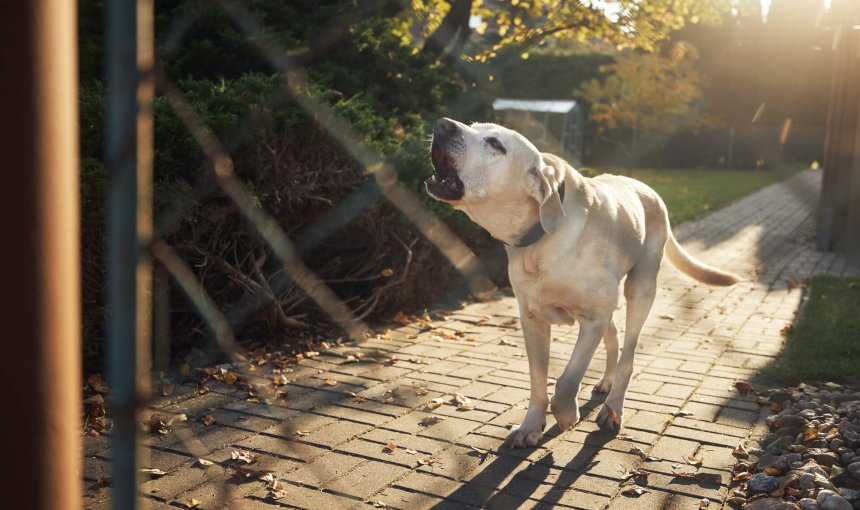 Approved by Dr. Dwight Alleyne, DVM
Approved by Dr. Dwight Alleyne, DVM What Does My Dog’s Barking Mean?
If you've got a dog barking more or less than usual, you might be wondering if there’s something going on. Read on to see the most common reasons for changes in your dog’s barking and what you can do.

Barking is how your dog communicates, so it’s a natural behavior. But if you’ve got a dog barking excessively… we do get it. So you might’ve wondered:how to get your dog to stop barking? Or what does my dog’s barking even mean? Here are a couple of the main reasons why – and where a Bark Monitor for dogs can come in handy.
Key Takeaways
Your dog barks to communicate, but if they bark too much, it usually means they are trying to tell you they are excited, bored, scared, or even in pain.
To get your dog to stop barking so much, you need to first figure out what is triggering them (like the mail carrier or a loud noise). Then, you should make sure they get enough exercise and have plenty of toys to keep them from getting bored.
If you are having trouble figuring out why your dog is barking, a Tractive GPS tracker has a built-in Bark Monitor. It can alert you if your dog is barking more than usual. This can help you and your vet figure out if the problem is stress, a health issue, or just an outside noise.

Always know your buddy is healthy & safe
Read moreWhy is my dog barking so much?
Barking might be a sign your dog is:
- Excited to see you (like when you come home from work or a vacation)
- Craving attention
- Hungry
- Bored
- Scared – like if there are fireworks in your neighborhood
- Protective about their territory (which could also be from a new housemate – like another pet or a baby)
- Anxious – especially if they’re not 100% used to you or their environment yet (like if you’ve just adopted them)
- In pain
- Surprised
- Growing older – especially if you’ve got a senior dog at home, that might be vulnerable to dementia
In many cases, you might’ve observed your dog barking at specific situations – like if there are loud, scary noises outdoors, or if the Amazon delivery truck is driving by. But if you’re noticing excessive barking, it’s your job as a responsible dog parent to get to the bottom of things.
💡A Tractive smart dog tracker with Bark Monitoring can help alert you if your dog is barking excessively – or otherwise showing signs of anxiety. We’ll cover it in detail a little further below.

Get health alerts for your dog
Our pups can’t always tell us if something’s wrong. But if their tracker detects unusual changes in their routine, you’ll get an alert, helping you catch potential issues early.
Why is my dog barking less?
Just like when dogs bark a lot to communicate, there are several reasons they might start barking less. Here are some possible explanations:
- Increased comfort
- Aging
- Training and behavior change
- Pain or fatigue
- Medical conditions like infections in the throat or larynx can make it harder for a dog to bark. These conditions can cause inflammation and discomfort.
Understanding the reasons behind your dog’s quieter behavior can help ensure they’re happy and healthy, and also give you peace of mind if you’re wondering why they’re barking less.
How to get your dog to stop barking
Figure out what triggers your dog’s barking
Much like with us humans, a change in your buddy’s routine can majorly stress them out. (Which might turn up as excessive barking.) So you might find yourself dealing with a barking dog if, for example, you’ve:
- Just adopted them, meaning they’re not 100% used to you or their new home yet.
- Shifted apartments, cities, or even countries – aka, bringing them to a new environment
- Changed your work schedule to, say, a night shift – so you aren’t around the “regular” times
- Moved to a “noisy” neighborhood, which might trigger your buddy’s noise anxiety
- Moved to a neighborhood bordering woodland territory – which might trigger your buddy’s prey drive (so a whole forest of “prey” animals to sniff out and chase!)
You can help your dog feel less anxious and stressed out by bringing back some regularity to their routine, whether that’s meal times, walks, playtime, and of course, tons of quality time together. This can help socialize them to their environment and teach them how to behave around other pets and people.
Also, keeping track of WHEN your dog tends to bark the most can help you get to the bottom of what factors in your environment might be triggering your dog’s barking behavior.
Ensure your dog is getting enough exercise
Excessive barking can be the result of a dog’s pent-up energy. So if you’ve both missed a few walks, it’s a good idea to get back on track – and stick to your daily routine of getting your dog their exercise. While different dog breeds need different amounts of exercise, most experts agree that at least 30 minutes of regular physical activity can do wonders. So besides regular walks, this can look like:
- Going running with your dog
- Exploring the hiking trails nearby
- Biking with your dog
- Camping with your dog
- Setting up a DIY agility training course in your backyard
Prevent your dog from getting bored
Like we’ve covered, boredom is a key reason you might find your dog barking like crazy – just for the sake of it. So if you’re headed off to work or vacation, make sure to set up an enriched environment for your buddy at home. Including:
- Chew toys
- Interactive puzzles
- A quiet, calm environment – maybe with some dog-friendly music. (Reggae and soft rock can work wonders in calming them down! Else, consider using a white noise machine.)
- Something with your scent, like a blanket or sweater, to help keep your buddy relaxed
- Treat dispensers that require your dog to “work” for their meals
- An indoor DIY obstacle course (using some pillows, chairs, and cushions) to keep them occupied
- Some company, like another pet, a pet sitter, friend, or family member checking up on them periodically (especially to let them out for a toilet break!)
Double down on your obedience training
There’s no substitute for regular training, but especially so for commands meant to discourage your dog from barking excessively. Throughout the process, make sure you stay patient and firm, without yelling. Getting mad at your dog for barking will just teach them that “barking = attention!”
Try and ignore your dog when they do bark, without making eye contact. So they gradually learn they won’t get your attention when they do. However, make sure to praise your dog plenty when they ARE quiet. Keep some treats ready and a ton of pats and praise when they’re behaving themselves. (And yes, with an enriched home environment, even the most hyperactive dog will eventually calm down.)
Got a dog that barks at the sound of the doorbell? Distract them in advance. Keep their favorite toys ready or train them to “Sit” when someone’s at the door. Another trick you can teach your dog is to “Fetch” a toy or some item around your house when, say, the doorbell rings. So your dog is too occupied with their “job” to show the new visitor who’s boss.
Finally, you can also get your dog used to the sounds or stimuli that trigger their barking. Like, for example, the doorbell ringing or the sounds of cars passing by or children playing outdoors. Play these sounds from a video or your phone when your dog is sitting quietly – and reward them if they don’t bark. (While ignoring them if they do.)
Read more: 4 Important Dog Commands & How To Teach ‘Em
Get in touch with your vet
Adjusted your environment, gotten your daily exercise and training down to pat – and still got a dog barking away? It might be time to check in with your vet.2 Because at least some of the time, your dog’s barking might be due to:
- Pain, especially if you touch them or pet them.
- Anxiety, which you can tell if your dog’s tail ends up tucked between their legs, their hackles raised, and their head usually lowered
- Cognitive decline, especially if you have a senior dog at home.
We’d also recommend taking a video on your phone when your dog’s barking. Your vet can be an important second pair of eyes to help you better understand your buddy’s behavior – and whether it’s cause for concern.
Why is my dog barking while asleep?
When dogs are in REM sleep, that’s when they’re usually dreaming. Which is why they might bark or “run” in their sleep – or at least have their limbs and paws mimicking the motion of running. Smaller dogs tend to alternate between REM and non-REM sleep more than bigger dogs. (As often as every 10 minutes!) So they might actually end up barking more while asleep.
Dogs might also whimper, cry, or howl in their sleep – which, sadly, can indicate they’re having a nightmare.
Why is my dog barking at nothing?
Your dog’s superpowered senses (including their smell, hearing, and even night vision) all play a role in your dog sensing unseen, unheard, undetected stimuli in your environment. Including:
- Bugs, including ticks and mites
- Sounds from outside and far away – including cars, other animals, and people
- The humming of your indoor appliances
So if your dog is barking at seemingly nothing, it’s possible something in your environment is still triggering it. (Even if you yourself can’t sense it. And nope, it’s still not a ghost, but most likely a raccoon outside.) In these cases, distract your dog with some attention and playtime – so you can wean them off this behavior. Make sure to reward them consistently when they are quiet and behaving themselves.
Read more: 13 Fun Games For Dogs (For When You’re Cooped Up Indoors)
But if you have a senior dog at home…
Unfortunately, if you have a senior dog at home barking seemingly at nothing and mostly around nighttime, one of the reasons may be cognitive decline. Senior dogs tend to experience a loss of their senses as they grow older – so their hearing, sight, and proprioception might not be what they used to be. As a result, senior dogs can experience increased or decreased barking, depending on the dog.
Oftentimes, this barking stops as suddenly as it starts – and you might observe your buddy barking into a corner or at a wall during night.
In these cases, make sure to get in touch with your vet. They can best advise you how to care for your senior dog, keep them mentally active, and prevent them from developing cognitive dysfunction.
Read more: Dog Dementia: Recognizing & Treating It
Should you use a dog muzzle for barking?
When it comes to deterring any specific behavior, experts generally discourage using a dog muzzle for barking. In general, you should only use a dog muzzle for short periods of time, under full supervision – and not for specific behaviors like barking or chewing.
In general, dog muzzles for barking aren’t an effective long-term solution. They might prevent your dog from doing so temporarily, but they don’t address the underlying cause of the barking in the first place. Rather, consistent training and tons of positive reinforcement go a much longer way when it comes to stopping a dog from barking.
“Never muzzle your dog to teach a lesson. You will do nothing to fix the underlying problem, and once again, your dog will learn to associate the muzzle with the punishment.
Now when you try to muzzle your dog in a legitimate situation like an emergency, your dog will be even more scared and nervous.“
– The American Kennel Club, “Dog Muzzles: When, Why, and How To Correctly Use Them5
What about a dog barking collar?
Also not ideal. Both vets and animal rights groups strongly discourage the use of e-collars or shock collars to deter any specific behavior. Even if the collar administers a low-level shock, there’s always the risk you’ll “shock” your dog far more severely than intended. (Especially if the remote falls in the wrong hands.)
Or a citronella collar?
Citronella collars come equipped with a microphone that picks up on your dog’s barking. If it crosses a certain threshold, the collar releases a fragrance that dogs find unpleasant. (Meant to deter them from barking too much.) However, there’s always the chance the microphone picks up on other dogs barking at a park or similar – and your poor buddy might be put through an olfactory assault even if they’re being good!
So if you’re dealing with a particularly bad case of barking and your dog’s environment doesn’t seem to be triggering it, it’s smart to leave some jobs to the pros. Enroll your buddy in an obedience training school – and make sure to refresh their training periodically to wean them off any “bad” behaviors.
How the Tractive Bark Monitor for dogs can help
If your dog has been barking more than usual, figuring out the cause can be a real mystery. That’s where a Bark Monitor can make a big difference. With one strapped to your dog’s collar, your trusty Tractive smart tracker tells you if intense barking was detected or if there was a change to their barking in the last 7 days.
This data can reveal patterns linked to potential triggers like separation anxiety, loud noises, or strangers passing by. Which, with time, can help you:
- Spot unusual behavior
If your dog is barking more or less frequently than normal, the monitor can highlight these changes, which might signal underlying issues such as stress, pain, or even illness.

- Detect signs of separation anxiety
Tractive’s Bark Monitor feature also comes with a Separation Anxiety Monitor. This lets you see if your dog is showing signs of separation anxiety while you’re apart – like intense barking – allowing you to take action sooner.

When you’re unsure about why your dog’s barking has increased, sharing data from a Bark Monitor with your vet can provide valuable context. It’s a helpful tool for discussing behavioral changes and exploring possible health concerns.
Using a Bark Monitor isn’t just about keeping track of the noise – it’s about understanding your dog better. Whether the issue is environmental, emotional, or medical, it can help you get to the root of the problem so you can make your dog feel more comfortable and secure.
Your furry friend’s health and wellbeing means as much as to us as it does to you. So we’ve made it a priority to only share medically-relevant content on our blog. This post was checked, double-checked, and medically verified by Georgia-based vet, Dr. Dwight Alleyne.

Dr. Dwight Alleyne, DVM
Originally from Long Island, New York, Dr. Alleyne began his career at a no-kill animal shelter before becoming a licensed veterinary technician. He graduated from Cornell University Veterinary College in 2006 and completed an internship at Purdue University. Now practicing in Georgia, Dr. Alleyne specializes in soft tissue surgery and ultrasounds. He also writes pet health articles on his website, “The Animal Doctor Blog” (www.anmldrblog.com).



